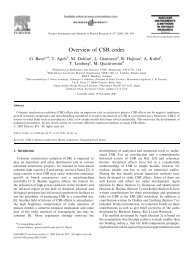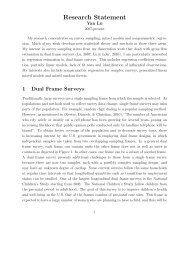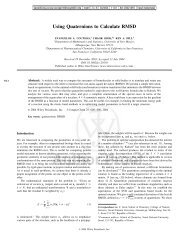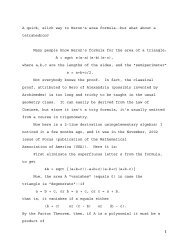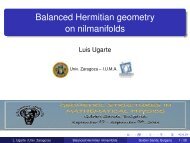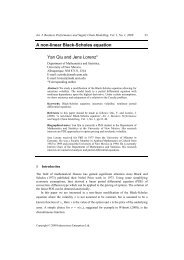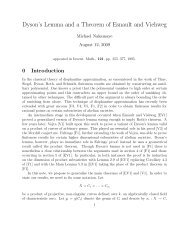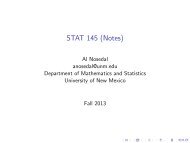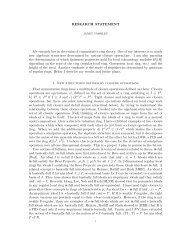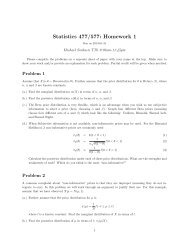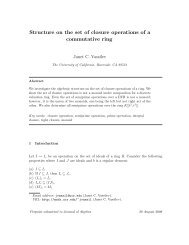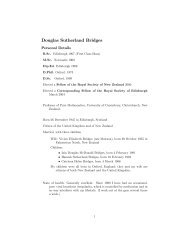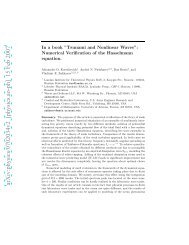OEO Office of Equal Opportunity - Department of Mathematics and ...
OEO Office of Equal Opportunity - Department of Mathematics and ...
OEO Office of Equal Opportunity - Department of Mathematics and ...
Create successful ePaper yourself
Turn your PDF publications into a flip-book with our unique Google optimized e-Paper software.
GEOGRAPHY 209<br />
Graduate Program<br />
Graduate Advisor<br />
Bradley Cullen<br />
bcullen@unm.edu<br />
Graduate applicants please direct correspondence to<br />
Graduate Advisor.<br />
Degree Offered<br />
M.S. Geography<br />
Concentrations: a) environmental analysis (human/environmental<br />
interaction) or b) geographic information technologies<br />
(GIS, GPS <strong>and</strong> remote sensing)<br />
A master’s degree is <strong>of</strong>fered under both Plan I <strong>and</strong> Plan II<br />
as described in the earlier pages <strong>of</strong> this catalog. Any student<br />
planning to go on for a Ph.D. is strongly urged to take Plan I<br />
<strong>and</strong> write a thesis. Graduate students entering the program<br />
without Introductory GIS <strong>and</strong> Spatial Analysis will be considered<br />
deficient <strong>and</strong> will take those courses without graduate<br />
credit. A minor may be taken under either plan with the<br />
approval <strong>of</strong> the Geography <strong>Department</strong>’s Graduate Advisory<br />
Committee. In place <strong>of</strong> a minor, approved courses in related<br />
fields may be substituted.<br />
Minimum requirements for the Geography M.S. degree are<br />
as follows:<br />
Plan I<br />
Credits<br />
GEOG 501 3<br />
GEOG 504 3<br />
One physical geography seminar: 512 or 513 3<br />
One GIT seminar: 521, 522 3<br />
Four graduate credit or 500-level geography courses 12<br />
Thesis 6<br />
Total 30<br />
Plan II<br />
GEOG 501 3<br />
GEOG 504 3<br />
Two other courses: 512, 513, 521, 522 or 545 6<br />
Seven additional graduate-credit or<br />
500-level geography courses 21<br />
Total 33<br />
C<strong>and</strong>idates under Plan I will be examined orally on their<br />
thesis. C<strong>and</strong>idates under Plan II will be tested with both oral<br />
<strong>and</strong> written examinations on a topic selected by his or her<br />
graduate committee from the three areas listed below. Part or<br />
all <strong>of</strong> the Plan II exam may be applied <strong>and</strong> require field work.<br />
A regional focus in any <strong>of</strong> the three topics is acceptable.<br />
1. Physical Geography.<br />
2. Human/Environmental Interaction.<br />
3. Geographic Information Technologies.<br />
A graduate student who elects to do a master’s degree in<br />
geography should have either an undergraduate degree in<br />
geography or be prepared to make up deficiencies as determined<br />
by the Geography <strong>Department</strong>’s Graduate Advisory<br />
Committee. Students must select an advisor who will help<br />
them design their programs <strong>and</strong> guide them through their tenure<br />
in the department. All programs are subject to approval<br />
by the Graduate Advisory Committee. Students must earn<br />
grades <strong>of</strong> B (3.0 GPA) or better in all courses on their plan<br />
<strong>of</strong> study, including those at the undergraduate level. GRE<br />
scores are required for application to the M.S. program.<br />
Geography (GEOG)<br />
101. Physical Geography. (3)<br />
World geography; physical elements. Use <strong>of</strong> maps <strong>and</strong><br />
globes for a systematic analysis <strong>of</strong> world climates, vegetation,<br />
soils <strong>and</strong> l<strong>and</strong>forms <strong>and</strong> their distribution, interrelation <strong>and</strong><br />
significance to human.<br />
102. Human Geography. (3)<br />
World geography; human elements. A systematic analysis <strong>of</strong><br />
world population, demographic factors, ethnic groups, predominant<br />
economies <strong>and</strong> political units <strong>and</strong> their distribution,<br />
interrelation <strong>and</strong> interaction with the physical earth.<br />
105L. Physical Geography Laboratory. (1)<br />
Exercises designed to complement 101. Applied problems<br />
in the spatial processes <strong>of</strong> the physical environment. Map<br />
construction <strong>and</strong> reading, weather <strong>and</strong> climatic analysis,<br />
classification <strong>of</strong> vegetative <strong>and</strong> soil associations, l<strong>and</strong>form<br />
distribution analysis.<br />
Pre- or corequisite: 101. Two hrs. lab.<br />
140. [201.] World Regional Geography. (3)<br />
The regional geography <strong>of</strong> the world. Both physical <strong>and</strong><br />
human aspects are studied along with current economic <strong>and</strong><br />
political problems.<br />
195. Survey <strong>of</strong> Environmental Issues. (3)<br />
Survey <strong>of</strong> environmental issues related to the degradation <strong>of</strong><br />
l<strong>and</strong>, air <strong>and</strong> water resources.<br />
251. Meteorology. (3)<br />
(Also <strong>of</strong>fered as EPS 251.) Description <strong>of</strong> weather phenomena,<br />
principles <strong>of</strong> atmospheric motion, weather map analysis<br />
<strong>and</strong> weather prediction.<br />
281L. Survey <strong>of</strong> Geographic Information Science.<br />
[Survey <strong>of</strong> Geographic Information Technologies.] (4)<br />
Examination <strong>of</strong> the spatial framework <strong>of</strong> geographical analysis<br />
<strong>and</strong> mapping tools used in the spatial sciences. Introduction to<br />
spatial methodology <strong>and</strong> concepts in Geographic Information<br />
Systems (GIS), Remote Sensing <strong>and</strong> Image Processing (RS/<br />
IP) <strong>and</strong> Global Positioning Systems (GPS). Fees required.<br />
Two hrs. lab.<br />
302. Regional Geography. (3 to a maximum <strong>of</strong> 6) ∆<br />
Geography <strong>of</strong> a selected region <strong>of</strong> the globe with focii on<br />
the national, economic, <strong>and</strong> social environments that are<br />
reflected in settlement systems. Includes analyses <strong>of</strong> current<br />
environmental <strong>and</strong> cultural issues.<br />
**344. Geography <strong>of</strong> New Mexico. (3)<br />
A geography <strong>of</strong> New Mexico which will concentrate on the<br />
natural, economic <strong>and</strong> social environments that relate to<br />
settlement systems. Includes a survey <strong>of</strong> settlement from<br />
prehistoric periods to the urban Rio Gr<strong>and</strong>e corridor.<br />
**345. Geography <strong>of</strong> the Southwest. (3)<br />
Interdisciplinary study <strong>of</strong> selected areas <strong>of</strong> the greater<br />
Southwest based on both physical character (physiography)<br />
<strong>and</strong> on cultural traces associated with pre-historic <strong>and</strong> historic<br />
settlement. Field component will be required.<br />
**351. Climatology. (3)<br />
An analysis <strong>of</strong> factors affecting climactic variations, including<br />
solar <strong>and</strong> terrestrial radiation, atmospheric temperature,<br />
pressure <strong>and</strong> wind patterns, the global hydrologic cycle <strong>and</strong><br />
atmospheric chemistry.<br />
352. Global Climate Change. (3)<br />
(Also <strong>of</strong>fered as EPS 352.) Comparison <strong>of</strong> natural <strong>and</strong><br />
anthropogenic causes <strong>of</strong> large-scale climate change. Factors<br />
influencing development <strong>of</strong> mitigation <strong>of</strong> adaptation policies.<br />
Prerequisite: 351.<br />
**356. Systematic <strong>and</strong> Regional Biogeography. (3)<br />
Concepts <strong>and</strong> theories <strong>of</strong> historical <strong>and</strong> evolutionary biogeography<br />
focusing on flowering plants <strong>and</strong> mammals from<br />
the Cretaceous to present. Biotic evolution <strong>of</strong> Realms <strong>and</strong><br />
Biomes in context <strong>of</strong> plate techtonics, glacial episodes <strong>and</strong><br />
modern human impacts.<br />
**359. Water in Environmental Systems. (3)<br />
The drainage basin is used as the fundamental unit for a<br />
quantitative analysis <strong>of</strong> the movement <strong>and</strong> storage <strong>of</strong> water<br />
in the hydrologic system. Applied l<strong>and</strong> <strong>and</strong> water use planning<br />
aspects are emphasized.<br />
ARTS AND<br />
SCIENCES<br />
UNM CATALOG 2006–2007 Symbols, page 611.



